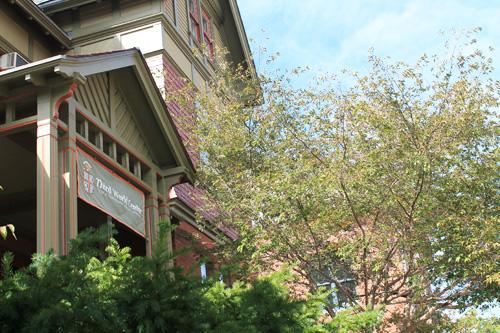PROVIDENCE, R.I. [Brown University] — A new five-year strategic plan — Visualize. Vocalize. Mobilize. — lays out an ambitious future for Brown’s Third World Center: new co-curricular programs, investments in staff and training, an activism series, an alumni network, improved accessibility for Partridge House, outreach to families, work with high schools, programs for the community, a social justice curriculum, enhancements to the Heritage Series — at least three dozen proposed projects in all.
Yet the big change is the new name.
After extensive consultations with students, alumni, and other interested parties, the TWC is re-branding itself as the Brown Center for Students of Color.
“We know that the Third World name has very deep roots with symbolic and historical associations,” said Mary Grace Almandrez, director of the Third World Center and assistant dean of the College, “and we intend to honor that legacy. Our self-study and external review, however, told us clearly that students of color at Brown were solidly in favor of a name change.”
The announcement of the new name is, in fact, the first action item on the center’s new five-year plan and has been approved by President Christina Paxson as “clear, simple and powerful, and it fits perfectly with the proposed mission statement.” In her letter accepting the report, Paxson announced that she would provide support for accessibility improvements to Partridge Hall. (The full strategic plan and the President’s letter are available online.)
The new name and the array of projects laid out in the strategic plan were developed during a long and very attentive process that involved students, former TWC directors, an independent external review, and many alumni of color.
“The conversations were starting when I entered Brown — in the fall of my freshman year,” said Floripa Olguin, now a junior, who served on the Strategic Planning Committee. “It was very important that students accompanied Dean Almandrez when she met with alumni groups. Alumni began to understand that the current center needed to shape itself for students of color, who were its current users.”
Generations of students had developed leadership skills through their work on projects at the center — what Olguin called a “strong, informal passing of leadership from class to class.” The five-year plan includes a more formal leadership development program that integrates theoretical models and community organizing strategies with experience at the center — enriching, not supplanting, a traditional TWC strength.
The same is true for other traditional strengths, including thoughtful activism and advocacy for social justice. The center will develop, implement, and evaluate a social justice curriculum that will prepare undergraduates and graduate students to lead social justice workshops for the University community.
The strategic planning process also reviewed activities at the center in the light of a more focused mission statement. “The center had some duties that seemed better for other offices,” said Angie Ocampo, a senior who served two years on the TWC student advisory board and was a member of the Strategic Planning Committee. “The First Generation Initiatives was one. There are something like 700 first-generation college students at Brown, and not all of them are students of color.”
In response to the growing number of first-generation students at Brown, the Division of Campus Life and the Office of the Dean of the College will lead a comprehensive initiative to support first-generation students. The center will be a partner in this work but will not take the lead, as the strategic plan notes that a broader approach to serving first generation students is needed.
Ocampo also noted that Commencement programming for TWC families, alumni, and graduating seniors — the Latino Commencement Dinner and the ONYX Rites of Passage Ceremony — is growing both in attendance and in strategic importance for the University. Funding for those events has outgrown the capacity of the center’s staff and is not sustainable. The center staff will present proposals for acquiring sustainable funding sources.
The Strategic Planning Committee felt it was appropriate for one of the center’s signature undertakings — the Third World Transition Program (TWTP) — to retain its name “as a way to honor alumni who played a vital role in the birth and development of the center.” The TWTP Endowment, established in 2012, will improve the program and allow it to expand beyond the four days preceding new student orientation in the fall. Family TWTP workshops and the TWTP Remix (for undergraduate and graduate students who could not attend TWTP) would expand the program’s reach, as would development of TWTP workshops for alumni clubs.
“We are mindful of the broader community,” Olguin said. “We respect alumni voices. We are not changing the center’s values, and we are honoring their legacy. In fact, it is partly through their activism — what they’ve done, what they’ve been doing — that I and others are able to be here.”

